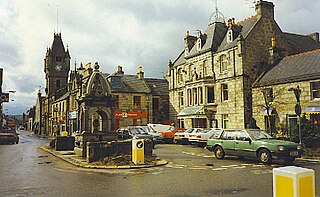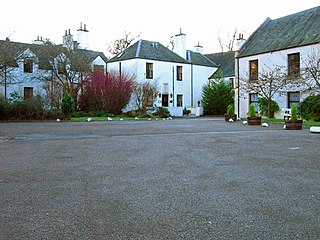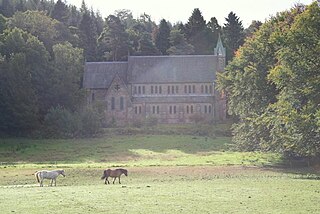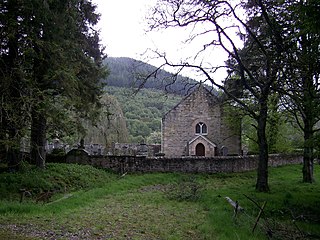Related Research Articles

Huntly is a town in Aberdeenshire, Scotland, formerly known as Milton of Strathbogie or simply Strathbogie. It had a population of 4,460 in 2004 and is the site of Huntly Castle. Its neighbouring settlements include Keith and Rothiemay. Both Huntly and the surrounding district of Gordon are named for a town and family that originated in the Border country.

Dufftown is a burgh in Moray, Scotland. While the town is part of the historic Mortlach parish, the town was established and laid out in the early 19th century as part of a planned new town settlement. The town has several listed 19th century buildings and serves as a regional centre for agriculture, tourism and services. The town is well known for its whisky based economy, as it produces more whisky than any other town in Scotland and is home to several existing and former distilleries.

Banffshire is a historic county, registration county and lieutenancy area of Scotland. The county town is Banff, although the largest settlement is Buckie to the west. It borders the Moray Firth to the north, Morayshire and Inverness-shire to the west, and Aberdeenshire to the east and south.

Turriff is a town and civil parish in Aberdeenshire in Scotland. It lies on the River Deveron, about 166 feet (51 m) above sea level, and has a population of 5,708. In everyday speech it is often referred to by its Scots name Turra, which is derived from the Scottish Gaelic pronunciation.

The King's Gallery, previously known as the Queen's Gallery. is an art gallery in Edinburgh, Scotland. It forms part of the Palace of Holyroodhouse complex. It was opened in 2002 by Queen Elizabeth II, and exhibits works from the Royal Collection.

Newmachar is a village in Aberdeenshire, Scotland, about 10 miles (16 km) to the north-west of Aberdeen.

Longside is a village located in Aberdeenshire, Scotland, consisting of a single main street. It lies seven miles inland from Peterhead and two miles from Mintlaw on the A950. Its population in 2001 was 721. The River Ugie flows through it.
Blairmore School was an independent boarding preparatory school in Glass near Huntly, Aberdeenshire until its closure in 1993. The site is now owned and used by a Christian organisation called Ellel Ministries International as a prayer, training and healing retreat centre.

Maryculter House is a historic house in the village of Maryculter, or Kirkton of Maryculter, in the Lower Deeside area of Aberdeenshire, Scotland.

Udny Parish Church, now in private ownership, was a congregation of the Church of Scotland at Udny Green, Aberdeenshire in the north-east of Scotland, some 15 miles north of Aberdeen. Formerly known as Christ's Kirk, it was designed by the City of Aberdeen architect John Smith in 1821. Sited on the north edge of the village green, it is within the ancient Udny Parish and the Formartine committee area. It is a Category B listed building.

Tyrie is a hamlet and parish in the Banff and Buchan district of Aberdeenshire, north-east Scotland. Tyrie is located on the A98 road, around 5.5 miles (8.9 km) south-west of Fraserburgh. Tyrie parish includes the larger settlement of New Pitsligo, 5 miles (8.0 km) to the south. There is a primary school in the village. Tyrie's St Andrew's Parish Church was built in 1800 and is a category B listed building. The church contains a Pictish symbol stone, known as the Raven Stone, which was discovered on the site of the old parish church. The ecclesiastical parish was united with Strichen parish in 2002.

Beldorney Castle is a Z-plan castle dating from the mid-16th century, about two miles south of Glass, in hilly country in the valley of the Deveron, in Aberdeenshire, Scotland.

St Peter's Roman Catholic Church is a large mid-nineteenth century church in Buckie, Moray, Scotland. Known locally as the Buckie Cathedral, it was built between 1851 and 1857, soon after the emancipation of Catholics in Scotland, to provide a place of worship for the local Catholic congregation. It was designed by James Kyle, Catholic bishop of Aberdeen, and built on land donated to the diocese by Sir William Gordon, Baronet of Letterfourie. It was extended and redecorated in the early twentieth century by Charles Ménart, and was designated a Category A listed building in 1972. It remains an active place of worship, under the governance of the Roman Catholic Diocese of Aberdeen.

The Church of The Incarnation was built between 1827 and 1829 as a Roman Catholic church, under the patronage of the Gordon family, in Banffshire, Scotland. It was originally built by John Gall, and finished between 1843 and 1844 by James Kyle with assistance from Walter Lovi. It was designated a Category B listed building in 1972, and upgraded to Category A in 1987. It ceased being used as an active church in 2012, and as of 2019 is on the Buildings at Risk Register for Scotland, described as being at moderate risk, and in poor condition.

St Margaret's Church is a church of the Scottish Episcopal Church near Aberlour in Moray, Scotland. It is Gothic in style, built mostly of tooled granite rubble, and has a cruciform layout with an east–west oriented nave, transepts to the north and south, and a slender tower at the south-west corner. Its interior is lavishly decorated with polished granite columns topped with ornately carved capitals, marble chancel furniture, and many stained glass windows depicting saints and biblical scenes.

St Rufus Church, also known as Keith Parish Church, is a Church of Scotland church in Keith, Moray, that was built in 1816. Designed by James Gillespie Graham in the Perpendicular Gothic style, it has crenellated walls, traceried windows and a tall bell and clock tower at its west end. The doorway leading into the nave from the entrance lobby is an unusual war memorial, listing the names of parishioners who died in the First World War on one side, and in the Second World War on the other.

Alexander Laing was a Scottish architect who was mainly involved in house and castle design.

Kirkmichael is a parish and hamlet in Moray, Scotland. Kirkmichael was historically part of Banffshire.

Banff Sheriff Court is a judicial structure in Low Street, Banff, Aberdeenshire, Scotland. The structure, which was the headquarters of Banffshire County Council and was also used as a courthouse, is a Category B listed building.
References
- 1 2 Staff. "History of Glass, in Aberdeenshire and Banffshire | Map and description". Vision of Britain. Retrieved 31 March 2020.
- ↑ Rodgers, Peggy (7 June 2020). "Glass (BAN), Banffshire". Genuki. Retrieved 22 July 2020.
- 1 2 Lewis, Samuel (1851). A Topographical Dictionary of Scotland. London,UK: S. Lewis & Co. p. 499. OCLC 1157994491. OL 22895439M .
- ↑ Mac an Tailleir, Iain (2003). "Gaelic place names in Scotland (Ainmean-àite)" (PDF). Scottish Parliament. p. 54. Archived from the original (PDF) on 16 November 2018. Retrieved 22 July 2020.
- ↑ "GB Historical GIS / University of Portsmouth, Glass ScoP through time | Population Statistics | Total Population". A Vision of Britain through Time. 2017. Retrieved 22 July 2020.
- ↑ Staff. "Glass School". Aberdeenshire Council. Archived from the original on 4 February 2013. Retrieved 10 May 2013.
- ↑ Staff. "Glass Primary School". Glass Primary School. Retrieved 31 March 2020.
- ↑ Gaiter, Phil (2019). "The Gordon Schools handbook 2019/2020" (PDF). Aberdeenshire Council. p. 17. Retrieved 31 March 2020.
- ↑ Staff. "Ellel Scotland". Ellel Ministries UK. Retrieved 31 March 2020.
- ↑ Staff. "Aswanley House". Canmore, Historic Environment Scotland. Retrieved 31 March 2020.
- ↑ Staff (2011). "Aswanley Scotland". Aswanley. Archived from the original on 2 May 2013. Retrieved 10 May 2013.
- ↑ Staff. "History - Gordon Family". Aswanley Scotland. Retrieved 31 March 2020.
- 1 2 Staff. "Glass Parish Church". Canmore, Historic Environment Scotland. Retrieved 31 March 2020.
- ↑ Staff. "Parish Church of Glass, Huntly, Strathbogie and Howe of Alford, Aberdeenshire". British Listed Buildings. Retrieved 31 March 2020.
- ↑ Lindsay, Maurice (1986) The Castles of Scotland. Constable. ISBN 0-09-473430-5 p78